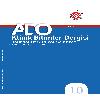MAKİNALI HASADA UYGUN BAZI PAMUK ÇEŞİTLERİNDE PAMUK YAPRAKPİRELERİ (Asymetresca decedens & Empoasca decipiens Paoli. Hem.: Cicadellidae)'NİN POPÜLASYON DEĞİŞİMİNİN BELİRLENMESİ
Çalışmada 2008 ve 2009 yılında makineli hasada uygun 9 farklı pamuk çeşidinde Pamuk Yaprak biti (Aphis gossypii Glov.) ve Pamuk Yaprak pireleri (Asymetresca decedens & Empoasca decipiens Paoli)'nin popülasyon değişimi incelenmiştir. Çalışmada yaprak biti yoğunluğu az olmasından dolayı değerlendirmeye alınmamış, yaprak pireleri değerlendirilmiştir. Çalışmanın yürütüldüğü her iki yılda da Pamuk Yaprak pireleri (Asymetrasca decedens, Empoasca decipiens )'nin yoğunluğu mücadele eşiğinin altında olmasına rağmen, denemeye alınan çeşitlerden Lider pamuk çeşidinde, pamuk yaprak piresi yoğunluğunun en düşük seviyede olduğu, bunu ST 468 ve GSN 12 çeşidinin takip ettiği, en yüksek zararlı popülasyonunun ise Nazilli 954 ve NAPA 122 çeşitlerinde görüldüğü belirlenmiştir. Tüylü çeşitlerdeki Empoasca spp. popülasyonunun diğer çeşitlere göre daha düşük seviyede olduğu görülmüştür. Ayrıca, en yüksek verimin tüy sayısı fazla ve zararlı yoğunluğunun düşük olduğu Lider çeşidinde görülmüştür. Sonuç olarak, zararlı yoğunluğunun ekonomik zarar eşiği üzerine çıkmasa da tüy miktarının zararlı yoğunluğu üzerinde etkili olduğu ve mücadelede önemli rol oynayabileceği düşünülmektedir.
Anahtar Kelimeler:
Pamuk çeşitleri, zararlılar, tüylülük, verim
Determine the Population Dynamics of Asymetresca decedens & Empoasca decipiens Paoli. (Hem.: Cicadellidae ) on Some Cotton Varieties
The study was conducted between 2008 and 2009 growing seasons at the cotton research institute of Nazilli in Aydın province. In the study, the population dynamics of Aphis gossypii Glov. and Asymmetrasca decedens and Empoasca decipiens Paoli were observed on nine cotton varieties which were harvested by the machine. During the two-year study, due to low amount of A. gossypii the population was not calculated. Therefore, population of Empoasca spp. was studied. During the study even the population of A. decedens and E. decipiens was under the economic injury level, the lowest population was observed on Lider variety followed by ST-468 and GSN 12 varieties. On the other hand, more populations were observed on Nazilli 954 and NAPA 122 varieties. Also, the highest yield was observed on Lider variety which has more hair density and low population amount. As a result, even the population was not reached to the economic injury level, the amount of the hair has impact on the population and should be useful against the insect in managment.
Keywords:
Cotton varieties, pests, hair, yield,
___
- Anonymous, 2008. Zirai Mücadele Teknik Talimatları Cilt 2. Başak Matbaacılık ve Tan. Hiz. Ltd. Şti Ankara.
- Anonymous, 2010. T.C. Sanayi ve Ticaret Bakanlığı Teşkilatlandırma Genel Müdürlüğü, 2010 Yılı Pamuk R a p o r u , h t t p : / / t g m . s a n a y i . g o v . t r / F i l e s / D o c u m e n t s / y e n i _ 2 0 1 0 - y i l i - p a m u k - r a p o - 27012011110342.doc. Erişim Tarihi. 26.07.2012
- Bailey, J. C., 1982. Influence of plant bug and leafhopper populations on glabrous and nectariless cotton. Environ. Entomol., 11 (5): 1011-1013.
- Bhat, M.G., Joshi, A.B. , Singh, G., 1984. Relative loss of seed cotton yield by jassid and bollwors in some cotton genotypes (Gossypium hirsutum L.) Indian J.Entomol., 46: 169-173.
- Butler, G. D., Wilson, F.D., Fishler, G. 1991. Cotton leaf trichomes and populations of Empoasca lybica and Bemisia tabaci Crop Protection 10 (6):461464.
- Delvare, G., 1996. Contribution to study of the insect fauna associated with cotton crop. Report on a mission in Turkey. July 15-20, 1996, CIRAD, 1-38.
- Efil, L., Özgür, A.F., İlkhan, A., 1999. Harran Ovasında farklı pamuk çeşitlerinde Thrips tabaci Lind. (Thysanoptera: Thripidae) ve Empoasca spp. ( H o m o p t e r a : C i c a d e l l i d a e ) ' n i n p o p ü l a s y o n gelişmesinin belirlenmesi. Harran Ün. Zir. Fak. Dergisi, 3 (3-4):97-106.
- Gençsoylu İ. 2001. Büyük Menderes Havzası pamuk alanlarında zararlılar ile doğal düşmanların farklı
- ISSN: 1304-7787
- Yayın Aralığı: Yılda 2 Sayı
- Başlangıç: 2004
- Yayıncı: Adnan Üniv. Ziraat Fak.
Sayıdaki Diğer Makaleler
Halil Dündar, İbrahim Gençsoylu, Habibe Küçük
Deniz Çoban, Cüneyt Süzer, Şükrü Yıldırım, Birsen Kırım, Şahin Saka, Kürşat Fırat
Kamil Küçükyılmaz, Ramazan Erkek
BİTKİLERDE ATP BAĞLI KASET (ABC) TAŞIYICI PROTEİNLERİNİN YAPISAL ÖZELLİKLERİ
Kentsel Çevrede Heykel Mekân Kullanıcı Etkileşimi Üzerine Analiz
Emine Malkoç, Çiğdem Kılıçaslan
TARİHTEN GÜNÜMÜZE TÜRKİYE'DE GÜVERCİN (Columba livia) YETİŞTİRİCİLİĞİ
